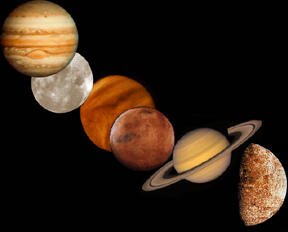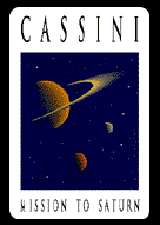The Cassini mission logo.
Click on image for full size
NASA/JPL
To Saturn We'll Go...
News story originally written on October 10, 1997
The last phase of approvals has ended for the Cassini mission as the White House Office of Science and Technology formalized its approval for the Cassini launch. Cassini will be launched from Cape Canaveral on October 13, 1997.
The Cassini probe will travel 7 years to reach Saturn's complex system of moons and rings. The Cassini mission is to study Saturn, its magnetosphere, its atmosphere, and its rings. The spacecraft,equipped with 12 scientific experiments, will orbit Saturn for 4 years.
Much like Galileo before it, Cassini will carry an atmospheric probe that will parachute into Titan's thick atmosphere. Titan is Saturn's largest moon. Its thick atmosphere is nitrogen-based like the Earth's, so scientists are hoping to make connections between the two worlds.
The Cassini mission is a joint endeavour of NASA, the ESA, and the Italian Space Agency. The main mission will end in July 2008.
You might also be interested in:

It was another exciting and frustrating year for the space science program. It seemed that every step forward led to one backwards. Either way, NASA led the way to a great century of discovery. Unfortunately,
...more
The Space Shuttle Discovery lifted off from Kennedy Space Center at 2:19 p.m. EST, October 29th. The sky was clear and the weather was great as Discovery took 8 1/2 minutes to reach orbit for the Unitied
...more
A moon was discovered orbiting the asteroid, Eugenia. This is only the second time in history that a satellite has been seen circling an asteroid. A special mirror allowed scientists to find the moon
...more
Will Russia ever put the service module for the International Space Station in space? NASA officials are demanding an answer from the Russian government. The necessary service module is currently waiting
...more
During a period of about two days in early May, 1998, the ACE spacecraft was immersed in plasma associated with a coronal mass ejection (CME). The SWICS instrument on ACE, which determines unambiguously
...more
J.S. Maini of the Canadian Forest Service has referred to forests as the "heart and lungs of the world." Forests reduce soil erosion, maintain water quality, contribute to atmospheric humidity and cloud
...more
In late April through mid-May 2002, all five naked-eye planets are visible simultaneously in the night sky! This is includes Mercury which is generally very hard to see because of its proximity to the
...more















